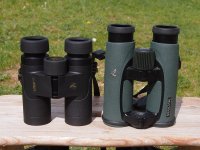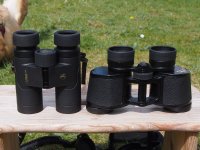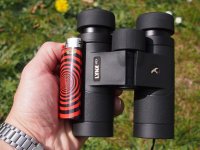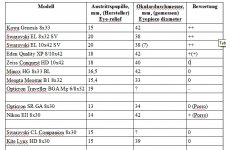Lee, I am old enough to use expressions like "auf den Pfennig achten"

Ok, here we go with the Lynx. I will post my experiences as they happen, so please dont expect anything stringent or in an orderly fashion. There will be a thorough review at the end, on my website, but here I will write down on the go. Please bear in mind that english is not my mother-tongue.
First of all, why the Kite Lynx HD 8x30? Quite simple, I read about it here and in another german bino forum. I got interested in it, because it was claimed to be small, lightweight and of very goog optical quality. Even more, it had this lovely, huge FOV of 151m and I do crave large FOVs.
So I contacted Kite Optics in Belgium and the agreed in sending me one for a limited period.
Let me explain my personal preferences with binoculars, as they may be of importance for you when reading my statements:
8x30/32 is my preferred class of bino because of size and weight. Compacts are difficult to look through and large, heavy binos are too much of a hassle to carry around.
I do like a large FOV and am quite sensitive to CA.
Very important, not many binos fit my eyes: Deep set ones with large eye-sockets, only a few binos make it easy for me to look through without constant re-adjustment and lots of kidney-beaning. ER and the diameter of the eyepieces seem to be the factors of importance for me, (see atattched file). The Kite does not score in this department, it takes me some effort to get a perfect view through it.
Yesterday I spend a leisurely hour in the garden, looking alternately through Nikon 8x30 EII, Swaro 8x32 EL WB and this Kite:
CA-wise the kite is on a level with the Nikon. Visible, but not hindering me having a good view.
There is a slight
field curvature to be seen with the Kite. But on a level where it does not prevent me using the whole FOV by having the eyes roam around as with the Nikon. (Roam around in the inner 75% before kidney-beans appear, as with all my binoculars)
Sweet spot is about 80%. Outside this sharpness drops off considerably, but can be re-focused. Enough to, for example, read a traffic sign and the letters printd on it. Not that I use the outer third of any FOV willingly, I like to center the bino on my target. But for what I call "peripheral viewing" this large FOV is perfectly usable.
As for
watching fine details on-axis, I found cobwebs on a tree, 5m away, for that purpose. Leftover strands, about 2-10cm long against a noisy background of dark green foliage. With all three binos, I could isolate the single strands from the surrounding environment. Best with the Swaro, then the Nikon followed closely by Kite. These were very fine differences, but visible ones. The Kite isolated the strands not as clearly as the Swaro and nearly up to the level of the Nikon. However you may call this: sharpness, resolution, micr-contrast, there were differences to be seen when watching fine details.
Ok, thats it for now. I am off into the woods with Nikon and Kite for having a look into the hazy distance of the Rhine valley.









